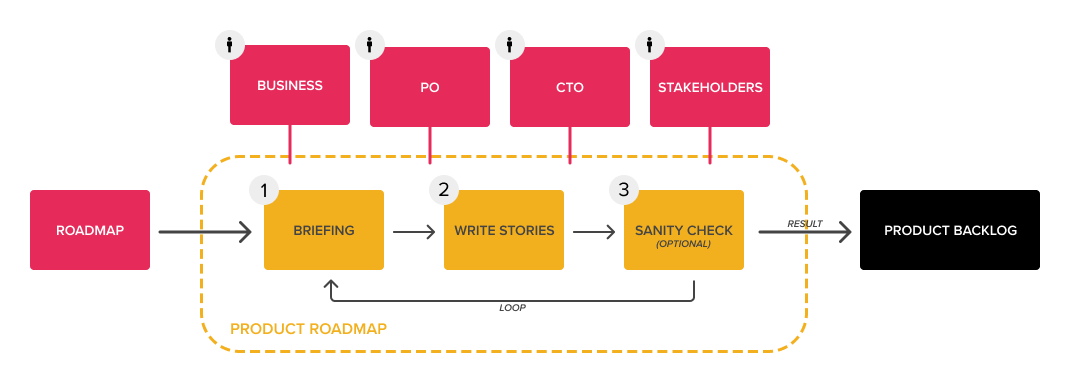Digital Product Strategy - How to Plan and Execute the Growth for Your Digital Business
So what makes product strategy so essential? And what are the principal components of a digital product strategy? Let's take...

However, to reap the full benefits of software development for your business, it’s essential to follow the right process – from product ideation all the way through to market launch and maintenance.
In the following article, we’re going to look at what it takes to develop a successful software product. We’ll take you through the recommended product development steps. We’ll also evaluate why it’s worth having a software development strategy and whether Agile is truly the most effective methodology.
Let’s jump right in.
Let’s start by explaining what software product development strategy is.
It’s a step by step plan which lists all the stages involved in the process of software development, along with key stakeholders, goals and objectives, and a project timeline. It includes a plan of action from ideation to product launch.
Creating a sound software product development strategy brings significant benefits. Some of them include:

Planning and implementing the right strategy when developing a digital product requires skills from many areas. That’s why it is so important to hire a manager with the right experience and an analytical mind.
The first step in the software product development process is creating a comprehensive vision for the product or service. One very effective method is organizing a brainstorming session or ideation workshop with your team and, if applicable, the software agency you’re planning to work with. Your goal is to dig deep into what the product seeks to offer its users, how it will fill the market need, and how you are planning to differentiate yourself from the competition.
Now that you know what the software product will offer, it’s time to conduct a feasibility analysis. It is a thorough study of both technical and business factors that can all influence your software development project’s outcome. This includes areas such as the expected product launch deadline, software development budget, key project milestones, and the estimated ROI. You must ensure that you’ve covered all aspects of your product development. Especially, according to a report by ApiumHub, the number one issue that disrupts software delivery deadlines is unrealistic expectations (according to 14.45% of respondents). These can be prevented by putting in the work before a single design or line of code has been drafted.
That said, by the end of this stage, you should also have a Software Requirements Specification document your designers and developers will use in the next stages.

When working in scrum, it is crucial to involve the right people to build a backlog that meets the real needs at a specific software development stage.
Based on the documentation, your designers will now begin drafting initial visual concepts for your product. Once you accept the direction presented in the wireframes, they will work on high-fidelity prototypes. After each design module is finalized, they will pass on the designs and documentation to the development team.
Development and coding is the longest stage in the software product development process. It’s about translating product requirements into an actual, usable product. Developers have to make sure that the code corresponds to product specifications and meets the stakeholders’ expectations. However, if all previous stages were carefully executed and the programmers ended up with a clear SRS document, which they can follow closely, the coding phase should go smoothly.
Now that the software has been coded, it’s time for testing to make sure there are no bugs or errors that would make the software hard to use or unusable. This process differs depending on the company, but usually, a team of Quality Assurance engineers applies a variety of frameworks and tools to conduct a set of tests, including:
Overall, this stage’s primary purpose is to be sure that the code is clean and that the end product meets business goals. Only then can we move to the implementation and launch phase.
This step is done based on an implementation plan – the freshly built and tested software is moved to production. If there are any product iterations required, only specific changes will be deployed. Depending on the product complexity, the iterations can be done as a single release – if the project is simple or done in stages – if the project is more advanced.
Maintenance is the ultimate stage in the software product development process. It aims to keep the software up and running. It includes software updates, upgrades, and polishing. The product can be modified based on user feedback to make sure it performs effectively. It’s also during the maintenance stage that new functionalities can be added to meet user needs better.
When you review the software product development services online, you might notice that many software consultancies choose to work in an Agile workflow. What does it entail, and does it really tread the path to success? Let’s take a look at what Scrum – a popular Agile-based framework – brings to the table.
Firstly, as Atlassian aptly explained, “the scrum framework is heuristic; it’s based on continuous learning and adjustment to fluctuating factors”. All the work happens in short release cycles known as sprints, which usually last one or two weeks. As each sprint is finalized with a retrospective, it gives your team room for readjusting or re-prioritizing work whenever required. It’s the time when the entire team discusses what worked, what didn’t, and what they can learn from each experience.

Agile is still the most popular methodology in software development. And what can we say – rightly so! / Source: Goodfirms.co
Next, in cooperating with external software development teams, Scrum promotes sound cooperation among all parties – developers, QAs, and stakeholders. The code is continuously tested, and any errors or bugs are quickly fixed, which helps assure high software quality. As a result, the risk of undetected issues is much lower than in the Waterfall software product development methodology.
Last but not least, Scrum has earned its place among top software development companies such as Google and Facebook for a good reason. Namely, the framework helped save the FBI’s doomed case management system project, which lost the bureau an astounding $405 million in unfinished project costs. According to Jeff Sutherland, the framework’s creator who was also responsible for bringing the system to life:
Excess staff was cut by more than 50 percent, user stories were created, and 21 two-week sprints were scheduled — an 85% decrease in the projected schedule.
Jeff Sutherland
Software product development is a complex process – to make it more organized and easier to follow, it’s highly recommended to create a cohesive project plan.
There are multiple benefits to implementing a software development strategy. Among others:
Before you proceed to software development, it is important to create a comprehensive project feasibility analysis. Specifically, you must evaluate what the intended software will offer, how it will be better than other solutions on the market, and estimate the budget, timeline, and expected return on the investment.
Last but not least, it isn’t easy to get things right the first time – which is why we recommend turning to an Agile software development methodology. As your team will be working in iterations, you will have the opportunity to constantly improve your code, learn from your experiences, and apply any project changes, should they be required.

So what makes product strategy so essential? And what are the principal components of a digital product strategy? Let's take...
What is Digital Transformation? The term digital transformation often gets associated with buzzwords like AI, blockchain, cloud, and automatization. But what...
There are many different app monetization strategies that you can use to generate revenue. In this article, we'll take a...